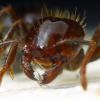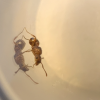Hello everyone! This is a very exciting day for me! After setting up, searching for and failing at finding a queen for a year, I finally found one! I was traveling on the I-5 heading to dinner and shopping at the Tejon Outlets at the base of the Grapevine between Los Angeles and Bakersfield. I got out of the car in front of the restaurant, looked down, and there she was, one wing left and scrambling about! I had nothing with me but my fingers and a plastic bag so with my wife and kids standing on the sidewalk not very enthused, and about 50 people staring oddly, I was able to not only embarrass my wife apparently, but catch my first queen! I filled the bag with air and put her in it for the ride home. She is now doing well in my Tar Heel Ants Atom formicarium. She is about 11mm long, dark red head, red thorax, and blackish colored abdomen. I thought maybe a Camponotus? Can anyone ID for me please? Still working on posting the photos. Thanks!
Edited by lpst, May 19 2018 - 9:53 AM.




























